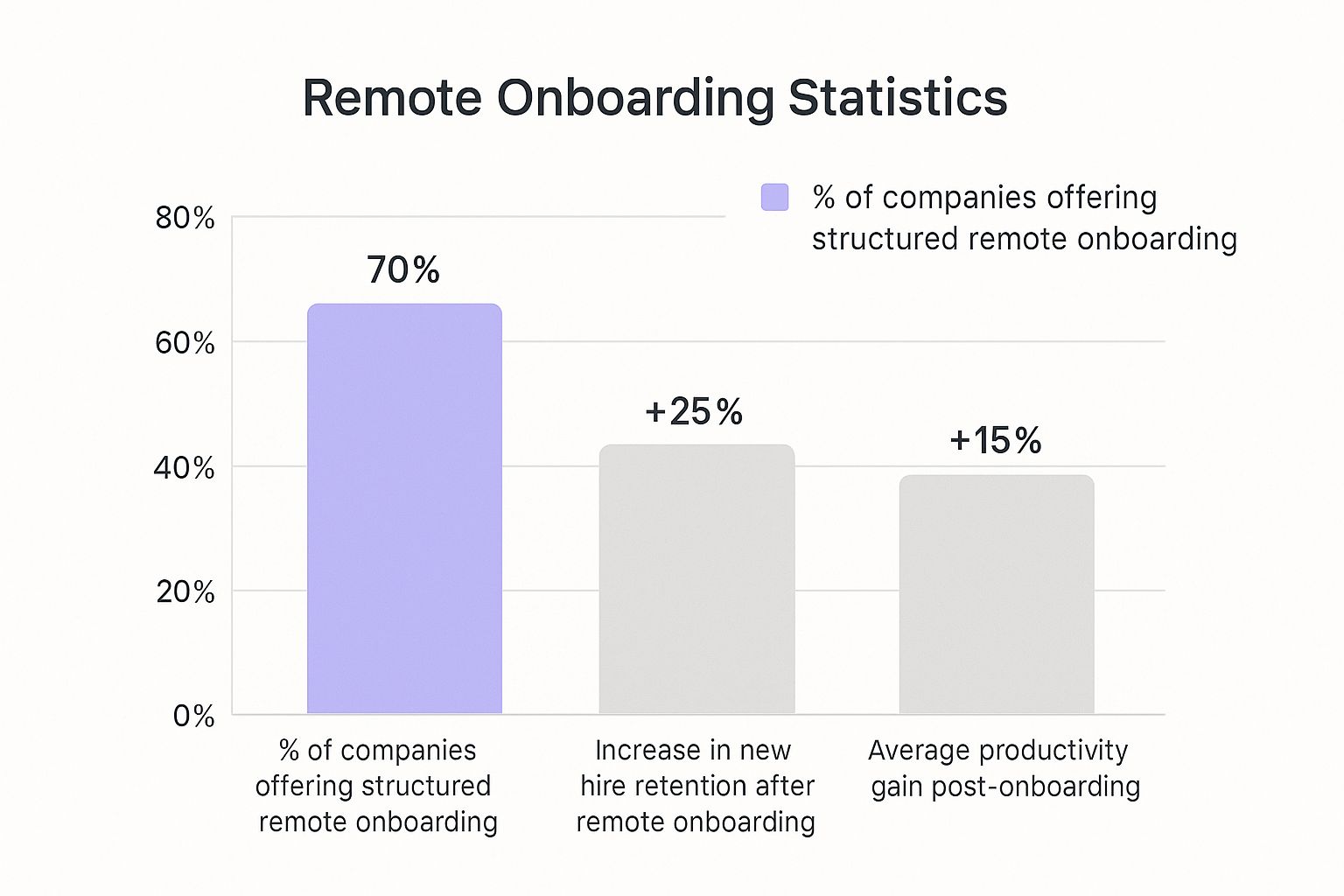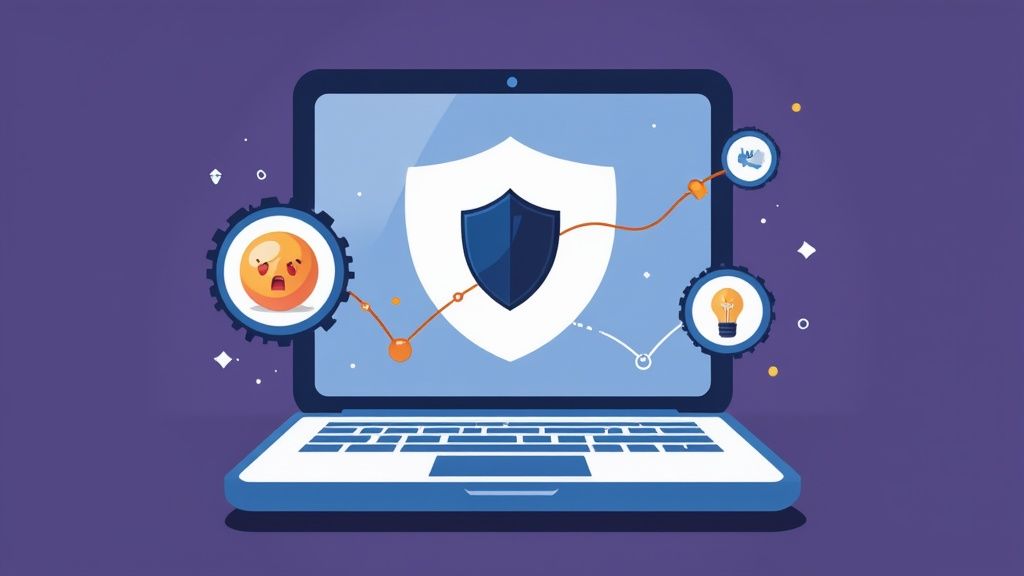
Let's be honest, onboarding for remote workers isn't just an HR checklist or a logistical task. It’s far more than just shipping a laptop and a welcome kit. It’s the very first, and most critical, opportunity you have to make a new hire feel seen, valued, and genuinely connected to your team from the moment they accept the offer.
Getting remote onboarding right is a high-stakes game. I’ve seen firsthand how a disjointed or impersonal experience can leave a brilliant new hire feeling isolated, confused, and second-guessing their decision. This quickly leads to burnout and, you guessed it, high turnover.
On the flip side, a thoughtful, structured process is a game-changer. It directly boosts retention, gets people contributing faster, and helps build a strong, cohesive culture, no matter where your team members are located. A poor first impression can sour a new hire’s entire journey with your company, while a great one builds loyalty from day one. This isn't just about administrative busywork; it's about intentionally weaving someone new into the fabric of your organization.
A well-oiled remote onboarding program can also help you sidestep many of the common challenges of a hybrid work environment by ensuring everyone, regardless of location, feels equally supported and integrated.
The numbers on this are impossible to ignore. Companies with strong onboarding programs report a 52% boost in employee retention, a 60% rise in productivity, and a 53% improvement in overall employee satisfaction.
Even more compelling? A meaningful onboarding journey makes a new employee 18 times more committed to the company compared to a lackluster one. The data is clear: investing in a quality onboarding process pays serious dividends.

The difference between a haphazard onboarding process and a thoughtfully designed one is night and day. One path leads to disengagement and quick exits, while the other builds loyalty and fast-tracks meaningful contributions. Recognizing these differences is the first step to building a program that actually works for your remote team.
A new hire's first few weeks are a fragile, high-stakes period. A structured plan replaces anxiety with confidence, transforming a new face on a screen into a valued, contributing team member.
To truly grasp the impact, it helps to see the outcomes side-by-side.
This table clearly contrasts the business results you can expect from a poor remote onboarding experience versus an effective one.
| Metric | Poor Onboarding Outcome | Effective Onboarding Outcome |
|---|---|---|
| Time to Productivity | 3-6 months, often longer | 1-2 months, with clear 30-60-90 day goals |
| First-Year Retention | High turnover; up to 20% leave in the first 45 days | Significantly higher, with strong employee loyalty |
| Team Integration | New hire feels isolated and disconnected | Feels welcomed, connected to colleagues and culture |
| Role Clarity | Confusion about expectations and responsibilities | Clear understanding of role, goals, and success metrics |
| Cultural Alignment | "Unwritten rules" are missed, leading to friction | Strong connection to company values and communication norms |
As you can see, the outcomes aren't even comparable. One approach sets people up for failure, while the other paves the way for success.
Ultimately, mastering this process is essential for attracting and keeping the best remote talent. This becomes even more critical when hiring across borders, where cultural and logistical nuances come into play. To learn more, check out our guide on the https://lathire.com/onboarding-process-for-remote-employees-from-latam/.
The onboarding journey for a remote worker doesn't start on day one. It begins the moment they accept your offer. That critical period in between—what we call "pre-boarding"—is your first real opportunity to quiet new-hire jitters and make a killer first impression. Done right, it transforms a name on a contract into a genuinely welcomed team member before they even log in for the first time.
This phase sets the entire tone for their experience with your company. A long, silent wait breeds doubt. On the other hand, a proactive, warm welcome builds immediate excitement and loyalty.

Nothing says "we weren't ready for you" louder than first-day tech problems. I've seen it happen too many times: a new hire's first day is wasted on IT tickets instead of team intros. The most common pitfall in remote onboarding is a simple failure to coordinate with IT ahead of time. Don't let this be you.
The second that offer is signed, kick off the hardware and software process. Your goal should be to have the new hire's laptop, monitors, and any other gear arrive at least three to five business days before they start. That buffer is non-negotiable—it's your safety net for shipping delays or setup snags.
If you're managing a growing remote team, understanding the nuances of choosing a Managed Service Provider can be a game-changer here, ensuring every new hire has professional IT support from the get-go.
Software access is just as important. Your new team member needs their email account, core software licenses (like Slack, Jira, or Microsoft 365), and initial system permissions ready to go. Send over their login details in a secure, easy-to-digest format a day or two before they officially start.
Think of a digital welcome packet less like a dense PDF and more like a curated, personal welcome mat. It's your chance to deliver essential info and build excitement without burying them in documents. We find that a simple page on Notion or a dedicated spot on your intranet works perfectly.
Here’s what a great welcome packet should include:
Remember, the point of pre-boarding isn't to get them to start work early. It's to clear away all the logistical and administrative noise so day one can be all about connection and learning, not paperwork and troubleshooting.
With the demand for flexible work arrangements soaring, getting these initial touchpoints right is more critical than ever. The demand for remote work is undeniable—a recent report found that 51% of global employees prefer fully remote roles. Companies that nail their remote-friendly policies, especially a strong onboarding experience, see a 25% reduction in employee turnover.
As your team becomes more global, it pays to understand the cultural nuances of your new hires. For example, taking a moment to learn what to expect when onboarding remote employees from LATAM can help you tailor your approach and build stronger connections from the start.
The first week is where all your pre-boarding efforts pay off—or fall flat. All that initial excitement can evaporate quickly if a new remote hire is met with technical headaches, an avalanche of documents, and a whole lot of awkward silence. A carefully planned first week is your secret weapon for setting a positive, productive tone that actually lasts.
Your goal here isn't to download every bit of company knowledge into their brain in five days. That’s a recipe for burnout. Instead, think of it as creating a balanced diet of structured learning, genuine human connection, and the freedom for them to explore on their own. This approach transforms what could be an overwhelming week into an energizing one.
Day one should be all about connection, not content. Before you even think about dropping them into complex training modules, make your new hire feel seen and welcomed as a person. The day should kick off with a warm, one-on-one welcome call from their direct manager to set a personal and supportive tone right away.
After that, a team-wide welcome meeting is a must. And please, don't make it a stiff, formal roundtable of "Hello, my name is…". Keep it light. Use fun icebreakers and have everyone share something that has nothing to do with work. This is ground zero for building the psychological safety a new remote hire needs to feel comfortable asking questions later on.
The afternoon should be much less structured. Block out time for things like:
This balanced approach ensures they sign off on their first day feeling connected and confident, not completely drained.
As the week unfolds, you’ll naturally introduce more structured training. The classic mistake here is to cram their calendar with back-to-back training sessions. This is a fast track to Zoom fatigue and information overload. A much smarter strategy is to weave social activities in between the learning modules.
For example, after a morning session on product knowledge, schedule a 30-minute introductory meeting with someone from a completely different department. This small touch helps the new hire see how their role fits into the bigger picture and starts building their internal network from day one.
Remember, the casual "water cooler" moments of an office don't exist for remote employees unless you intentionally create them. Scheduling short, informal chats is just as important as scheduling formal training.
This kind of intentional social planning is especially critical in a remote setup. Research shows that employees who start remotely can have higher rates of early turnover, often because they struggle to form strong social bonds. A well-designed first week directly tackles this issue by fostering the very connections that build loyalty. You can dig deeper into the findings on early career remote work to see the data for yourself.
To keep new hires from feeling like they’re adrift in a sea of links and documents, you need a single source of truth. All onboarding materials, schedules, and resources should live in one central, easy-to-find place. A dedicated knowledge base or a well-organized page on a tool like Confluence or Notion works perfectly.
A clean, organized "home base" like the one shown above gives a new hire a lifeline. With clear navigation for schedules, team directories, and key documents, you empower them to find answers on their own. This not only builds their confidence but also saves your existing team from answering the same basic questions over and over. For remote workers, this kind of organized structure is absolutely essential.
Company culture in a remote setup is one of those things that feels abstract—until it's broken. Unlike in an office, it doesn’t just happen through osmosis. You have to intentionally design, communicate, and nurture it, especially during the critical onboarding for remote workers. This is about so much more than just policies; it's about the daily rhythm of your workplace and making someone feel they truly belong.
A new hire’s ability to quickly grasp "how things get done around here" is a massive factor in their success and confidence. Without a physical space to observe social cues, they're essentially flying blind unless you provide a clear map. This is where deliberate cultural integration becomes a non-negotiable part of your onboarding.

Every company has them—the unspoken norms about communication, meetings, and collaboration. In an office, a new person picks these up by watching others. For a remote hire, these invisible rules can create serious anxiety and confusion.
The fix? Make the implicit explicit.
Create a living document, a "How We Work" guide, that lives in a central hub like Confluence or Notion. Think of it not as a formal employee handbook, but as a practical, real-world operating system for your team.
Here's what this culture guide should cover:
This single document demystifies your culture and empowers new hires to jump in confidently from day one. It replaces guesswork with genuine clarity.
You can't force friendships, but you absolutely can create the space for them to grow. Genuine connection is the antidote to the isolation that can easily creep into remote work. The goal is to consciously structure opportunities for the informal, "watercooler" interactions that happen naturally in a physical office.
Think beyond the awkward, mandatory virtual happy hour. Real connection stems from shared interests and low-pressure conversations.
A dedicated non-work Slack channel is one of the easiest, most effective ways to build rapport. A channel for pets, another for cooking, or one for book lovers creates micro-communities within your company where people can be themselves.
Leadership needs to set the tone here. Managers and executives should actively participate in these social channels and virtual events. When a leader shares a picture of their weekend hike or their new puppy, it signals that it’s safe and encouraged for everyone to bring their whole selves to work.
As your team grows, understanding these dynamics becomes even more critical. You can find excellent strategies in our guide on how to manage remote teams across different cultures, which offers practical advice for fostering inclusive connections.
Ultimately, culture is shown, not just told. Your onboarding process itself is one of the most powerful demonstrations of your company’s values.
Consider these actions to bring your culture to life:
By weaving these elements into your onboarding, you do more than just integrate a new employee. You reinforce your culture, build deep-seated loyalty, and set the stage for a long, successful partnership.
There's an old saying: "Clarity is kindness." It's never more true than when you're bringing a new remote worker into the fold. A job description just isn't enough. Your new hire needs to know, in concrete terms, what success looks like in their first few weeks and months. Without the casual check-ins and ambient cues of an office, ambiguity quickly breeds anxiety and imposter syndrome.
The best way to sidestep this problem is with a structured plan and clear milestones. This isn't about micromanaging; it's about providing a roadmap. It helps them see their role's impact, build confidence, and align their efforts with team goals from day one. You'll find their time-to-productivity shrinks dramatically, and they'll feel like a valued contributor much sooner.

A 30-60-90 day plan is your secret weapon for remote onboarding. It breaks down that overwhelming first quarter into smaller, more manageable chunks. Think of it as a framework for success, shifting the focus from just being "busy" to achieving meaningful outcomes.
Here’s a simple way to think about it:
A well-structured 90-day plan is the ultimate cure for new-hire anxiety. It answers the silent question every new employee has: "Am I doing what's expected of me?"
Here’s what that looks like in practice for a new remote hire.
Month 1 Goals (Days 1-30): Focus on Learning
The goal here is total immersion. They need to get a feel for the company's pulse, its tools, and the people.
Month 2 Goals (Days 31-60): Focus on Contributing
Now it's time to start applying that knowledge. The goal is to move from passive learning to active participation.
Month 3 Goals (Days 61-90): Focus on Owning
This is where they start operating more independently and driving their own initiatives. They should feel confident enough to take the lead on certain tasks.
This progression gives new hires a tangible sense of accomplishment, which is incredibly powerful when they're working alone from a home office.
Setting goals is great, but it’s only half the job. Regular, structured check-ins are where the real magic happens. This is your chance to give feedback, clear up confusion, and show your support. These aren't just casual "how's it going?" DMs; they are dedicated conversations tied directly to the 90-day plan.
For remote employees, these meetings are a critical lifeline. They're the substitute for the organic guidance that happens naturally in an office. I've found that doubling up on one-on-ones for the first 90 days is a fantastic way to build a strong foundation.
Here’s how to make these check-ins count:
This kind of structured feedback loop is absolutely essential for onboarding remote workers effectively. It builds trust, prevents misunderstandings, and ensures that by the end of three months, your new hire is confident, fully integrated, and ready to make a real impact.
Even with the perfect blueprint, you're bound to run into some specific challenges when onboarding remote employees. It just comes with the territory. This is where we tackle the most common questions I hear from managers and HR leaders who are in the trenches, building their programs.
Think of this as your go-to guide for those "what do I do when…" moments. We'll get straight to the point with answers you can use immediately.
This is the big one. When you can't just grab lunch or chat by the coffee machine, making someone feel like they belong takes real, intentional effort. It's all about engineering the casual, human connections that offices create by default.
It’s not enough to just add them to meetings. You have to show them they’re a valued person, not just a name on a task list.
Here are a few things that work wonders:
#pets, #what-we-are-cooking, #gaming, or #book-club. This is where real friendships start to form.Most remote onboarding failures come from one root cause: a lack of intention. Trying to just copy-paste your in-office process for a remote world is a guaranteed recipe for disaster. The dynamic is completely different, and your approach has to be, too.
The absolute worst mistake is the "IT-only" onboard. You know the one: you ship them a laptop and then vanish. This treats onboarding as a logistical problem, not a human one. It's the fastest way to make someone feel like an isolated afterthought.
Watch out for these other common pitfalls:
You can't improve what you don't measure. Figuring out if your program is successful isn't just a gut feeling; it’s about looking at the right data—a mix of hard numbers and human feedback. Combining them gives you the full story of what’s working and what needs a tune-up.
Keep an eye on these key indicators:
| Data Type | Metric to Track | What It Really Tells You |
|---|---|---|
| Quantitative | Time-to-Productivity | How fast a new hire starts making meaningful contributions. |
| Quantitative | First-Year Retention Rates | The ultimate report card on how well you're integrating and keeping talent. |
| Qualitative | New Hire Satisfaction Surveys | Pulse checks at 30, 60, and 90 days to see how they're feeling. |
| Qualitative | Manager Feedback | The manager's perspective on the new hire's integration and performance. |
Tracking this stuff moves you from guesswork to a data-driven strategy. It helps you see if the problem is in the first 30 days or if you need to improve cultural integration down the line.
Yes. 100% yes, if you can swing it in your budget. In a world of screens and video calls, something you can physically touch is incredibly powerful. A welcome kit isn't just a box of branded swag; it’s a tangible "unboxing" experience that makes the company feel real.
This one act can make a new hire feel valued and excited from the moment it lands on their doorstep. It creates a physical connection to your brand and culture before they've even logged on for their first meeting. A well-curated kit with a quality mug, a comfy t-shirt, a nice notebook, and some stickers shows you’re invested in them as a person and genuinely thrilled to have them on board.
